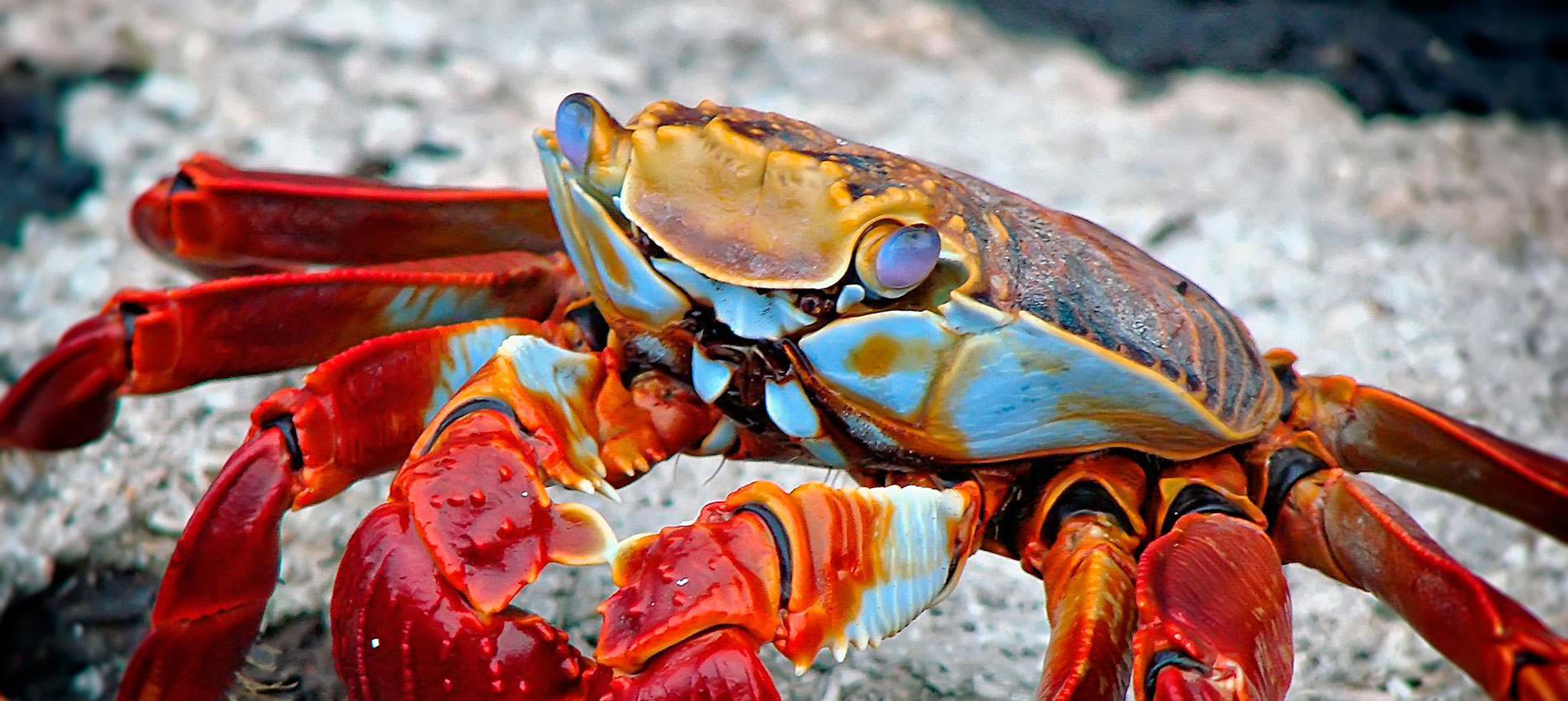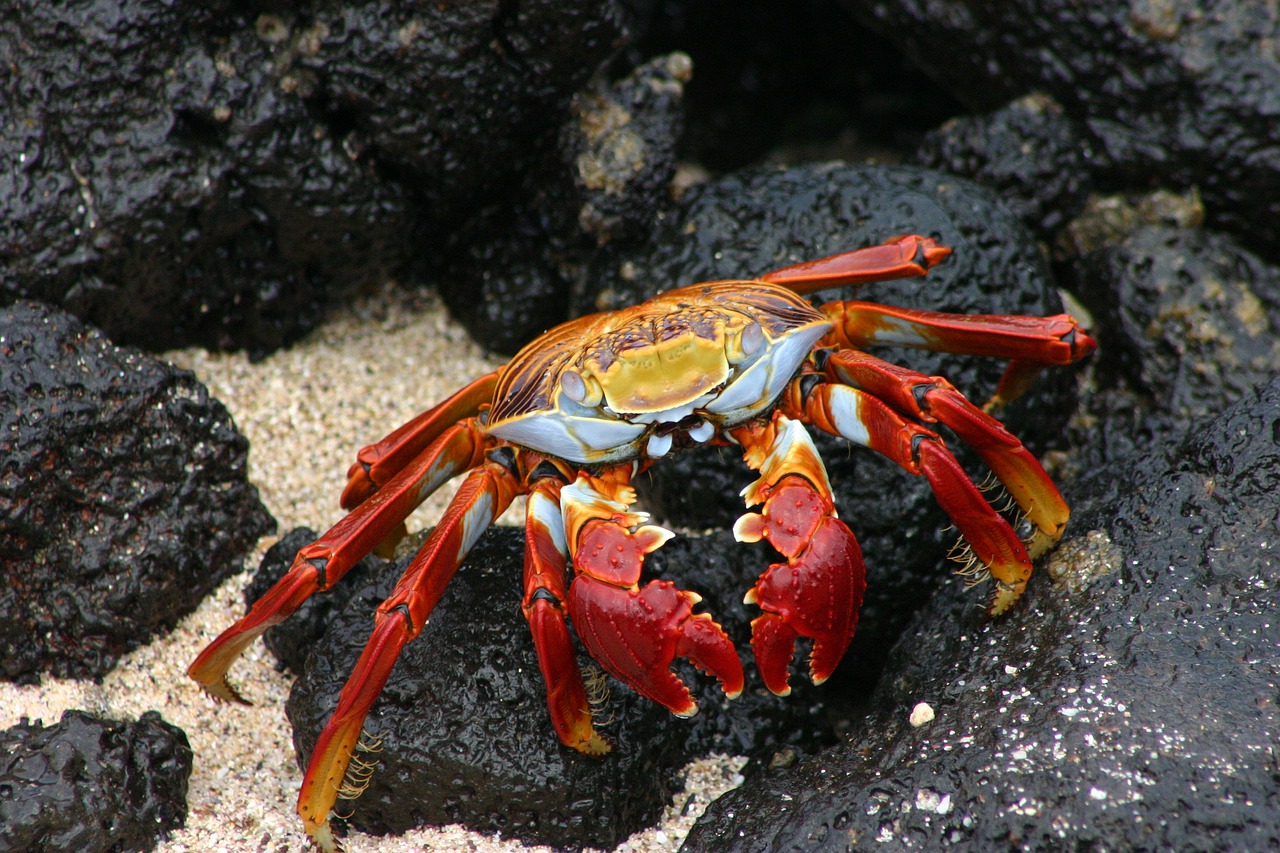Galapagos Crab - Sally Lightfoot Crab On A Lava Rock Galapagos Stock Photo Image Of Lateinamerika Orange 81321664 Galapagos Islands Galapagos Crab / This prevents them from being washed away, even in powerful surf.
Galapagos Crab - Sally Lightfoot Crab On A Lava Rock Galapagos Stock Photo Image Of Lateinamerika Orange 81321664 Galapagos Islands Galapagos Crab / This prevents them from being washed away, even in powerful surf.. They will stick the tips of their legs in the tiny holes in the lava and hold on tight. Hermit crabs, which carry seashells on their back, are found in tidepools, and pale ghost crabs also inhabit island shores. The crab is rumored to have been named after a caribbean dancer, which is no small wonder given its ability to run in four directions (forwards, sideways and backward). Photo credit—glen bjerke which of the following are serious environmental threats in the galapagos? With their bright red and orange shells standing in stark contrast to their black lava rock habitats, the red rock crab (or sally lightfoot crab) is one of galapagos' most startling and agile sea creatures, known for their apparent ability to 'walk on water', and springtime sees hundreds of them scuttling along the seashore.
Shot during a very short work trip to galapagos in feb. The legs of the crab have hooks instead of feet, allowing them to clutch the lava rock tightly. Most of us have seen crabs just running away from us. Galapagos islands, spanish islas galápagos, officially archipiélago de colón (columbus archipelago), island group of the eastern pacific ocean, administratively a province of ecuador.the galapagos consist of 13 major islands (ranging in area from 5.4 to 1,771 square miles 14 to 4,588 square km), 6 smaller islands, and scores of islets and rocks lying athwart the equator 600 miles. Maps were disabled by the visitor on this site.

In fact today researchers announced they'd found four new species of king crabs, brining the total known to 113.
We are working with partners, however, to assess the risks of marine plastic pollution to wildlife as part of our plastic pollution free galapagos programme. The galapagos islands is an excellent place to see sally lightfoot crabs, especially on the islands of santiago, floreana, española, san cristobal, and fernandina. Because of their pointed legs (they don't really have feet), galapagos sally lightfoot crabs can get an amazing hold on the lava rocks. Ejemplar de una zayapa ( grapsus grapsus ), cerro brujo, isla de san cristóbal , islas galápagos , ecuador. 8.31 mb sally lightfoot.jpg 3,072 × 2,048; A brightly red and yellow colored sally lightfoot red rock crab walks on its tiptoes across the rocks at water's edge. I don't think that anyone (besides a crab researcher or a beach bum) has seen a crab actually eating. Handcrafted s1 • e1 how to butcher an entire cow: With their bright red and orange shells standing in stark contrast to their black lava rock habitats, the red rock crab (or sally lightfoot crab) is one of galapagos' most startling and agile sea creatures, known for their apparent ability to 'walk on water', and springtime sees hundreds of them scuttling along the seashore. Most of us have seen crabs just running away from us. A typical crab shape with the front appendages as claws and the rear as flattened swimming paddles allowing them to swim in the water column unlike other crabs. A sally lightfoot crab in galapagos is not necessarily a rare sight, but they are regarded as scavenger animals that feed on anything that can be used to survive. The legs of the crab have hooks instead of feet, allowing them to clutch the lava rock tightly.
Find 293 tripadvisor traveller reviews of the best crab and search by price, location, and more. I don't think that anyone (besides a crab researcher or a beach bum) has seen a crab actually eating. Red rock crab, galapagos islands, ecuador. They will stick the tips of their legs in the tiny holes in the lava and hold on tight. This way, they can avoid falling off, even when powerful waves wash over them.

Maps were disabled by the visitor on this site.
We are working with partners, however, to assess the risks of marine plastic pollution to wildlife as part of our plastic pollution free galapagos programme. Hermit crabs, which carry seashells on their back, are found in tidepools, and pale ghost crabs also inhabit island shores. Importantly, one of the new species lives around the galapagos islands, in warm water. There are currently no projects specifically focused on the conservation of the galapagos ghost crab. This is one reason of many to visit the galapagos islands. A sally lightfoot crab in galapagos is not necessarily a rare sight, but they are regarded as scavenger animals that feed on anything that can be used to survive. A typical crab shape with the front appendages as claws and the rear as flattened swimming paddles allowing them to swim in the water column unlike other crabs. Find 8,697 tripadvisor traveller reviews of the best lobster and search by price, location, and more. It leaves a characteristic pattern of sand balls that are seen on most sandy beaches. A red rock crab (grapsus grapsus), cerro brujo, san cristobal island, galapagos islands, ecuador. A brightly red and yellow colored sally lightfoot red rock crab walks on its tiptoes across the rocks at water's edge. With their bright red and orange shells standing in stark contrast to their black lava rock habitats, the red rock crab (or sally lightfoot crab) is one of galapagos' most startling and agile sea creatures, known for their apparent ability to 'walk on water', and springtime sees hundreds of them scuttling along the seashore. Because of their pointed legs (they don't really have feet), galapagos sally lightfoot crabs can get an amazing hold on the lava rocks.
The galapagos islands is an excellent place to see sally lightfoot crabs, especially on the islands of santiago, floreana, española, san cristobal, and fernandina. With their bright red and orange shells standing in stark contrast to their black lava rock habitats, the red rock crab (or sally lightfoot crab) is one of galapagos' most startling and agile sea creatures, known for their apparent ability to 'walk on water', and springtime sees hundreds of them scuttling along the seashore. They have an extremely generalist diet, feeding on anything from sea lion placenta to other crabs. This is one reason of many to visit the galapagos islands. Hungry crab at galapagos islands by marcello march 28, 2014.

Maps were disabled by the visitor on this site.
The sally lightfoot crab is one of the many charismatic species that inhabits the galápagos islands and is often seen in photos of the archipelago, sometimes sharing the seaside rocks with the marine iguanas. Importantly, one of the new species lives around the galapagos islands, in warm water. Now there is one of each of the main galapagos wildlife. With their bright red and orange shells standing in stark contrast to their black lava rock habitats, the red rock crab (or sally lightfoot crab) is one of galapagos' most startling and agile sea creatures, known for their apparent ability to 'walk on water', and springtime sees hundreds of them scuttling along the seashore. It leaves a characteristic pattern of sand balls that are seen on most sandy beaches. Galapagos islands, spanish islas galápagos, officially archipiélago de colón (columbus archipelago), island group of the eastern pacific ocean, administratively a province of ecuador.the galapagos consist of 13 major islands (ranging in area from 5.4 to 1,771 square miles 14 to 4,588 square km), 6 smaller islands, and scores of islets and rocks lying athwart the equator 600 miles. A sally lightfoot crab in galapagos is not necessarily a rare sight, but they are regarded as scavenger animals that feed on anything that can be used to survive. Best crab in galapagos islands, ecuador: Shot during a very short work trip to galapagos in feb. A typical crab shape with the front appendages as claws and the rear as flattened swimming paddles allowing them to swim in the water column unlike other crabs. 8.31 mb sally lightfoot.jpg 3,072 × 2,048; This prevents them from being washed away, even in powerful surf. Ejemplar de una zayapa ( grapsus grapsus ), cerro brujo, isla de san cristóbal , islas galápagos , ecuador.

Komentar
Posting Komentar